Rationing

Rationing is the controlled distribution of scarce resources, goods, or services, or an artificial restriction of demand. Rationing controls the size of the ration, which is one's allowed portion of the resources being distributed on a particular day or at a particular time.
Rationing is often done to keep price below the equilibrium (market-clearing) price determined by the process of supply and demand in an unfettered market. Thus, rationing can be complementary to price controls. An example of rationing in the face of rising prices took place in the various countries where there was rationing of gasoline during the 1973 energy crisis.
A reason for setting the price lower than would clear the market may be that there is a shortage, which would drive the market price very high. High prices, especially in the case of necessities, are undesirable with regard to those who cannot afford them. Traditionalist economists argue, however, that high prices act to reduce waste of the scarce resource while also providing incentive to produce more.
Rationing using ration stamps is only one kind of non-price rationing. For example, scarce products can be rationed using queues. This is seen, for example, at amusement parks, where one pays a price to get in and then need not pay any price to go on the rides. Similarly, in the absence of road pricing, access to roads is rationed in a first come, first served queueing process, leading to congestion.
Authorities which introduce rationing often have to deal with the rationed goods being sold illegally on the black market.
Civilian rationing
Rationing has been instituted during wartime for civilians. For example, each person may be given "ration coupons" allowing him or her to purchase a certain amount of a product each month. Rationing often includes food and other necessities for which there is a shortage, including materials needed for the war effort such as rubber tires, leather shoes, clothing and fuel.
Rationing of food and water may also become necessary during an emergency, such as a natural disaster or terror attack. In the U.S., the Federal Emergency Management Agency (FEMA) has established guidelines for civilians on rationing food and water supplies when replacements are not available. According to FEMA standards, every person should have a minimum of 1 US quart (0.95 L) per day of water, and more for children, nursing mothers and the ill.[1]
Origins
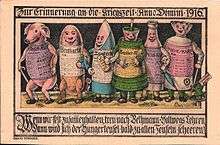
Military sieges have often resulted in shortages of food and other essential consumables. In such circumstances, the rations allocated to an individual are often determined based on age, sex, race or social standing. During the Siege of Lucknow (part of the Indian Rebellion of 1857) a woman received three quarters the food ration a man received and children received only half.[2]:71 During the Siege of Ladysmith in the early stages of the Boer War in 1900 white adults received the same food rations as soldiers while children received half that. Food rations for Indian people and black people were significantly smaller.[3]:266–272
The first modern rationing systems were brought in during the First World War. In Germany, suffering from the effects of the British blockade, a rationing system was introduced in 1914 and was steadily expanded over the following years as the situation worsened.[4] Although Britain did not suffer from food shortages, as the sea lanes were kept open for food imports, panic buying towards the end of the war prompted the rationing of first sugar and then meat.[5] It is said to have in the most part benefited the health of the country,[6] through the 'levelling of consumption of essential foodstuffs'.[7] To assist with rationing, ration books were introduced on 15 July 1918 for butter, margarine, lard, meat and sugar. During the war, average calories intake decreased only three percent, but protein intake six percent.[6] Food rationing appeared in Poland after the First World War, and ration stamps were in use until the end of the Polish–Soviet War.
Second World War
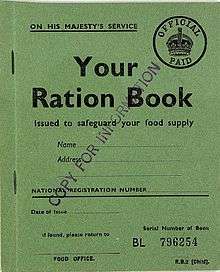
Rationing became common during the Second World War. Ration Stamps were often used. These were redeemable stamps or coupons, and every family was issued a set number of each kind of stamp based on the size of the family, ages of children and income. The British Ministry of Food refined the rationing process in the early 1940s to ensure the population did not starve when food imports were severely restricted and local production limited due to the large number of men fighting the war.[8]
Rationing on a scientific basis was pioneered by Elsie Widdowson and Robert McCance at the Department of Experimental Medicine, University of Cambridge. They worked on the chemical composition of the human body, and on the nutritional value of different flours used to make bread. Widdowson also studied the impact of infant diet on human growth. They studied the differing effects from deficiencies of salt and of water and produced the first tables to compare the different nutritional content of foods before and after cooking. They co-authored The Chemical Composition of Foods, first published in 1940 by the Medical Research Council. Their book "McCance and Widdowson" became known as the dietician's bible and formed the basis for modern nutritional thinking.[9]
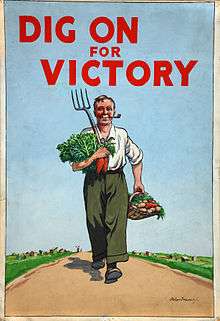
In 1939, they tested whether the United Kingdom could survive with only domestic food production if U-boats ended all imports. Using 1938 food-production data, they fed themselves and other volunteers a limited diet, while simulating the strenuous wartime physical work Britons would likely have to perform. The scientists found that the subjects' health and performance remained very good after three months. They also headed the first ever mandated addition of vitamins and mineral to food, beginning with adding calcium to bread. Their work became the basis of the wartime austerity diet promoted by the Minister of Food Lord Woolton.[9]
Britons' actual wartime diet was never as severe as in the Cambridge study because imports from America successfully avoided the U-boats,[10] but rationing improved the health of British people; infant mortality declined and life expectancy rose, discounting deaths caused by hostilities. This was because it ensured that everyone had access to a varied diet with enough vitamins.[11][12]
The first commodity to be controlled was gasoline. On 8 January 1940, bacon, butter and sugar were rationed. This was followed by successive ration schemes for meat, tea, jam, biscuits, breakfast cereals, cheese, eggs, lard, milk and canned and dried fruit. Fresh vegetables and fruit were not rationed but supplies were limited. Many people grew their own vegetables, greatly encouraged by the highly successful 'digging for victory' motivational campaign.[13] Most controversial was bread; it was not rationed until after the war ended, but the "national loaf" of wholemeal bread replaced the ordinary white variety, to the distaste of most housewives who found it mushy, grey and easy to blame for digestion problems.[14] Fish was not rationed but price increased considerably as the war progressed.[15]

In summer 1941 the British appealed to Americans to conserve food to provide more to go to Britons fighting in the Second World War. The Office of Price Administration warned Americans of potential gasoline, steel, aluminum and electricity shortages.[16] It believed that with factories converting to military production and consuming many critical supplies, rationing would become necessary if the country entered the war. It established a rationing system after the attack on Pearl Harbor.[17]:133 In June 1942 the Combined Food Board was set up to coordinate the worldwide supply of food to the Allies, with special attention to flows from the U.S. and Canada to Britain.
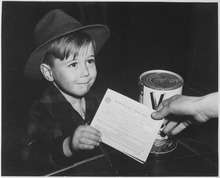
American civilians first received ration books—War Ration Book Number One, or the "Sugar Book"—on 4 May 1942,[18] through more than 100,000 school teachers, PTA groups and other volunteers.[17]:137 Sugar was the first consumer commodity rationed. Bakeries, ice cream makers and other commercial users received rations of about 70% of normal usage.[18] Coffee was rationed nationally on 27 November 1942 to 1 pound (0.45 kg) every five weeks.[19] By the end of 1942, ration coupons were used for nine other items.[17]:138 Typewriters, gasoline, bicycles, footwear, silk, nylon, fuel oil, stoves, meat, lard, shortening and oils, cheese, butter, margarine, processed foods (canned, bottled, and frozen), dried fruits, canned milk, firewood and coal, jams, jellies and fruit butter were rationed by November 1943.[20]
The work of issuing ration books and exchanging used stamps for certificates was handled by some 5,500 local ration boards of mostly volunteer workers selected by local officials. As a result of the gasoline rationing, all forms of automobile racing, including the Indianapolis 500, were banned.[21] All rationing in the United States ended in 1946.[22]
Rationing Propaganda and the Role of Women During WWII
World War II was a time that challenged ideal gender roles. This can be seen through the propaganda used to popularize the rationing measure. Despite the call to all Americans to restrict their spending and consumption habits, an abundance of rationing propaganda posters portrayed women as the main actors of the measure; other posters also portray the call for women to participate in the military, which depicts the traditional gender roles that women had during the war as well as the emerging roles during this period in history. The posters were often directed towards women, and emphasize on their roles by picturing females who are well dressed, and who take pride in their role as homemakers. The gender roles portrayed reflect the history of the definition of the ideal housewife, and reinforce white women as the epitome of womanhood, which was an idea that emerged greatly because of colonialism and eugenics. Several posters depict women as the main actors in the rationing system, and picture women carrying traditional "feminine" activities, such as grocery shopping, cooking, mending clothes, among others. This traditional genre role, however, was changed by the new employment that hundreds of women acquired thanks to the war industry and the regular working force (men) being overseas fighting the war. The original intention about women's employment in factories was for it to be temporary, however, the new found sense of empowerment produced by the new jobs was not something that could have been reversed. Many women were happy to go back to being housewives after the war, however, it was not the case for many other women, who chose to stay in the public sphere by working outside of the home.[23] Women found a new dimension that they could belong to thanks to propaganda portraying women as strong and capable of doing a "man's job." Propaganda such as the Rosie the Riveter inspired and empowered women, and gave birth to ideas of equality, and of women no longer being the weaker sex. Propaganda during World War II influenced the new possibilities for women, and changed gender roles in the U.S. for ever.
Peacetime rationing
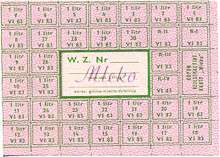
Civilian peacetime rationing of food has also occurred in history, especially after natural disasters, during contingencies, or after failed governmental economic policies regarding production or distribution, the latter happening especially in highly centralized planned economies.
In the United Kingdom, the rationing system remained in place for many years after the end of the War. In some respects it was more strict after the war than during it—two major foodstuffs that were never rationed during the war, bread and potatoes, went on ration after it (bread from 1946 to 1948, and potatoes for a time from 1947). Tea was still on ration until 1952. In 1953 rationing of sugar and eggs ended, and in 1954, all rationing finally ended when cheese and meats came off ration.[8] Sugar was again rationed in 1974 after Caribbean producers began selling to the more lucrative United States market.[24]
Many centralized planned economies introduced a peacetime rationing system due to food shortages in the postwar period. North Korea and China did so in the 1970s and 1980s, Communist Romania during the 1980s, the Soviet Union in 1990–1991, and Cuba today.
A good example of this system was Poland. In the immediate post-war period, rationing was in place until 1948. Shortages of food products were common in Poland at that time, but food rations also served another purpose. Cards were unevenly distributed by the Communist authorities—leading udarniks, known in Poland as przodownicy pracy, were entitled to as much as 3700 calories daily, while some white-collar workers received as little as 600 calories a day. Rationing covered more than food products. From April 1952 to January 1953 and from August 1976 to November 1985 ration stamps were introduced for shoes, cigarettes, sugar, sweets, liquor, soap, baby diapers, tires, and cars.

From 1949 to 1959, Israel was under a regime of austerity, during which a state of rationing was enforced. At first, only staple foods such as oil, sugar, and margarine were rationed, but it was later expanded, and eventually included furniture and footwear. Every month, each citizen would get food coupons worth 6 Israeli pounds, and every family would be allotted a given amount of food. The average Israeli diet was 2,800 calories a day, with additional calories for children, the elderly, and pregnant women.
Following the 1952 reparations agreement with West Germany, and the subsequent influx of foreign capital, Israel's struggling economy was bolstered, and in 1953, most restrictions were cancelled. In 1958, the list of rationed goods was narrowed to just eleven, and in 1959, it was narrowed to only jam, sugar, and coffee.

Petroleum products were rationed in many countries following the 1973 oil crisis.
Refugee aid rations
Aid agencies, such as the World Food Programme, provide fortnightly food rations and other essentials to refugees or internally displaced persons who are registered with the UNHCR and are either living in refugee camps or are supported in urban centres. Every registered refugee is given a ration card upon registration which is used for collecting the rations from food distribution centres. The amount of 2,100 kcal allocated per person per day is based on minimal standards and frequently not achieved, such as in Kenya.[25][26]
Other types
Health care rationing
As the British Royal Commission on the National Health Service observed in 1979, "whatever the expenditure on health care, demand is likely to rise to meet and exceed it." Rationing health care to control costs is regarded as an explosive issue in the USA, but in reality health care is rationed everywhere. In places where the government provides healthcare rationing is explicit. In other places people are denied treatment because of personal lack of funds, or because of decisions made by insurance companies. The American Supreme Court approved paying doctors to ration care, saying that there must be "some incentive connecting physician reward with treatment rationing".[27] Shortages of organs for donation forces the rationing of organs for transplant even where funding is available.
See also Healthcare rationing in the United States
Credit rationing
The concept in economics and banking of credit rationing describes the situation when a bank limits the supply of loans, although it has enough funds to loan out, and the supply of loans has not yet equalled the demand of prospective borrowers. Changing the price of the loans (interest rate) does not equilibrate the demand and supply of the loans.
Carbon rationing
Personal carbon trading refers to proposed emissions trading schemes under which emissions credits are allocated to adult individuals on a (broadly) equal per capita basis, within national carbon budgets. Individuals then surrender these credits when buying fuel or electricity. Individuals wanting or needing to emit at a level above that permitted by their initial allocation would be able to engage in emissions trading and purchase additional credits. Conversely, those individuals who emit at a level below that permitted by their initial allocation have the opportunity to sell their surplus credits. Thus, individual trading under Personal Carbon Trading is similar to the trading of companies under EU ETS.
Personal carbon trading is sometimes confused with carbon offsetting due to the similar notion of paying for emissions allowances, but is a quite different concept designed to be mandatory and to guarantee that nations achieve their domestic carbon emissions targets (rather than attempting to do so via international trading or offsetting).
See also
- Military rations
- 2007 Gas Rationing Plan in Iran
- Combat Ration One Man
- Juntas de Abastecimientos y Precios, rationing in Chile under Allende
- Road space rationing
- Salt lists
- Siege of Leningrad
- United States military ration
References
Notes
- ↑ "Food and Water in an Emergency" (PDF). FEMA.
- ↑ Inglis, Julia Selina (1892). The siege of Lucknow : a diary (1892). London: James R. Osgood, McIlvaine & Co.
- ↑ Nevinson, Henry Wood (1900). Ladysmith: The Diary of a Siege (1900). New Amsterdam Book co.
- ↑ Heyman, Neil M. (1997). World War I. Greenwood Publishing Group. p. 85.
- ↑ Hurwitz, Samuel J. (1949). State Intervention in Great Britain: Study of Economic Control and Social Response, 1914-1919. pp. 12–29.
- 1 2 Beckett, Ian F.W. (2007). The Great War (2 ed.). Longman. pp. 380–382. ISBN 1-4058-1252-4.
- ↑ Beckett attributes this quotation (page 382) to Margaret Barnett, but does not give further details.
- 1 2 Nicol, Patricia (2010). Sucking Eggs. Vintage Books. ISBN 9780099521129.
- 1 2 Elliott, Jane (2007-03-25). "Elsie - mother of the modern loaf". BBC News.
- ↑ Dawes, Laura (2013-09-24). "Fighting fit: how dietitians tested if Britain would be starved into defeat". The Guardian. Retrieved 25 September 2013.
- ↑ "Wartime Rationing helped the British get healthier than they had ever been". 21 June 2004. Retrieved 20 January 2013.
- ↑ "History in Focus: War – Rationing in London WWII". Retrieved 20 January 2013.
- ↑ Regan, Geoffrey (1992). The Guinness Book of Military Anecdotes. Guinness Publishing. pp. 19–20. ISBN 0-85112-519-0.
- ↑ Calder, Angus (1969). The People's War: Britain 1939–45. pp. 276–277.
- ↑ Ministry of Agriculture and Fisheries (1946). Fisheries in war time: report on the sea fisheries of England and Wales by the Ministry of Agriculture and Fisheries for the Years 1939–1944 inclusive. H.M. Stationery Office.
- ↑ ""Creamless Days?" / The Pinch". Life. 1941-06-09. p. 38. Retrieved December 5, 2012.
- 1 2 3 Kennett, Lee (1985). For the duration... : the United States goes to war, Pearl Harbor-1942. New York: Scribner. ISBN 0-684-18239-4.
- 1 2 "Sugar: U. S. consumers register for first ration books". Life. 1942-05-11. p. 19. Retrieved November 17, 2011.
- ↑ "Coffee Rationing". Life. 1942-11-30. p. 64. Retrieved November 23, 2011.
- ↑ "Rationed Goods in the USA During the Second World War". Ames Historical Society.
- ↑ "Historic Pittsburgh: Chronology". University of Pittsburgh.
- ↑ "World War II Rationing". Online Highways.
- ↑ Stoops, Jamie. [Lecture "Professor"] Check
|url=value (help). Pima Community College. Retrieved March 24, 2016. - ↑ "Rationing starts as sugar shortage looms". The Guardian. 9 July 1974. p. 3.
- ↑ https://www.wfp.org/faqs#faq14
- ↑ https://www.wfp.org/news/news-release/wfp-forced-reduce-food-rations-refugees-kenya
- ↑ "The Nation: The 'R' Word; Justice Souter Takes on a Health Care Taboo". New York Times. 18 June 2000. Retrieved 19 May 2015.
Bibliography
- Allocation of Ventilators in an Influenza Pandemic, Report of New York State Task Force on Life and the Law, 2007.
- Matt Gouras. "Frist Defends Flu Shots for Congress." Associated Press. October 21, 2004.
- Stiglitz, J. & Weiss, A. (1981). Credit Rationing in Markets with Imperfect Information, American Economic Review, vol. 71, pages 393-410.
External links
| Wikimedia Commons has media related to Rationing. |
| Look up ration or rationing in Wiktionary, the free dictionary. |
- Are You Ready?: An In-depth Guide to Citizen Preparedness - FEMA
- short descriptions of World War I rationing - Spartacus Educational
- a short description of World War II rationing - Memories of the 1940s
- Ration Coupons on the Home Front, 1942-1945 - Duke University Libraries Digital Collections
- World War II Rationing on the U.S. homefront, illustrated - Ames Historical Society
- Links to 1940s newspaper clippings on rationing, primarily World War II War Ration Books - Genealogy Today
- Tax Rationing
- Recipe for Victory:Food and Cooking in Wartime
- war time rationing in UK